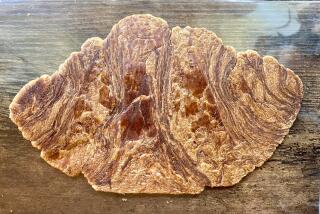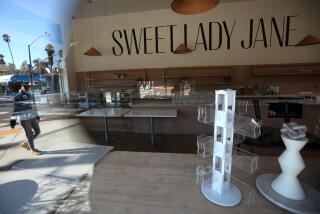Alice Medrich: Way beyond chocolate
There’s an episode of the late-’90s PBS series “Baking With Julia” that features Berkeley-based pastry chef Alice Medrich (in some circles, fondly referred to as the Queen of Chocolate) and one of her cakes -- a beautifully executed spectacle of framboise-soaked, chocolate genoise layered with chocolate mousse, whipped crème fraîche and raspberries, wrapped ‘round with a sheet of chocolate, topped with elaborate chocolate ruffles and dusted with powdered sugar.
No wonder that by the end of the episode, both Medrich and Child need a seat and a glass of Champagne.
Though undoubtedly delicious (she’s also not called the First Lady of Chocolate for nothing), no such chocolate-raspberry ruffle cake makes an appearance in Medrich’s new cookbook, “Pure Dessert.” Instead, you’ll find a simple, elegant almond cake decorated only with the handful of toasty, sliced almonds that line the cake pan.
How easy is it to make? As Medrich says: “It starts with whole almonds in the food processor, and two minutes later, you have batter.” A far cry from having to triple-sift cocoa with flour. Or there’s a vinsanto chiffon cake, served plain with a little whipped cream and maybe a few orange slices drizzled with more of the sweet wine and some honey. It’s Medrich unruffled: no glazes, no mousses, no frostings.
With the ruffles swept away, we can now appreciate Medrich’s gift for combining flavors: corn tuiles with salt and pepper, a cake scented with sesame oil and vanilla, figs roasted with cardamom. And her guidance in coaxing the best texture from often-adventurous ingredients.
Medrich founded Cocolat, a chocolate dessert company, in the 1970s (it was sold in the ‘90s) and has written and contributed to several cookbooks. (By the way, the recipe for that chocolate-raspberry cake later was published in the book “Baking With Julia.”)
“Pure Dessert” lives up to its subtitle, “true flavors, inspiring ingredients, and simple recipes.” Chapters are categorized by flavors: milk; grains, nuts and seeds; fruit; chocolate; honey and sugar; herbs and spices, flowers and leaves; and wine, beer and spirits.
In each chapter are recipes for tarts, cakes, cookies and ice creams, with an occasional recipe for candied citrus peel or chocolate pudding or honey caramels. It’s not intuitive when you’re looking for, say, cake recipes, but that’s what the index is for. It’s great when you have a farmers market fruit or special ingredient on hand.
I found myself returning again and again to the grains, nuts and seeds chapter, which includes some of the book’s most intriguing recipes: bourbon-nutmeg pound cake made with whole wheat or spelt flour, golden kamut shortbread (kamut is an ancestor of modern wheat), sesame seed cake, whole-wheat sablé cookies with cacao nibs, and those corn tuiles (thin, crisp, wafer-like cookies) with salt and pepper.
Sweet and salty
The corn tuiles came out amazingly thin and crisp, light and delicate. They’re made with corn flour, finely ground cornmeal (Bob’s Red Mill brand is available at Whole Foods markets and at health-food stores). The flavor of corn is heightened by the cookie’s sweetness, which is in turn balanced by a sprinkling of salt and pepper.
Medrich suggests eating the tuiles on their own, or -- refreshing to hear in a dessert book -- with a selection of cheeses. In one of the instructional sections interspersed throughout the book, she points out that tuiles carry flavor so well because they don’t require egg yolks (just whites), which she says can have a dulling effect.
And her smart, creative versions -- jasmine tea, dried lavender, fresh thyme, crushed saffron, freshly grated cinnamon -- take full advantage. Her tuile batter is great because you don’t even have to refrigerate it before shaping the cookies.
Medrich is exacting when it comes to measuring flour and includes in all recipes both the weight and volume measurements for flour. If you have a scale, use it, for the tuile recipe especially; a little too much flour will render a not-so-delicate cookie.
And the delicacy of her cookies is what makes them so elegant. Whole-wheat sablés are tender and fine-crumbed and perfectly baked. The recipe suggests adding hempseed, currants, hazelnuts or cacao nibs to the dough; I tried the cacao nibs. The nutty flavor of the wheat and the deep-chocolate flavor of the cacao nibs were a perfect combination, and the nibs melt a little during baking but keep much of their crunchiness.
The shortbread crust for tarts was somewhat disappointing. It’s fabulously easy to make; mix together melted butter, sugar, salt, vanilla and flour, then press the dough right into the pan. But maybe because of all that melted butter, it slumps into the “corners” of the pan during baking.
I got much better results from her cake recipes -- such as the vinsanto chiffon cake. It had a perfectly moist-but-light texture and with the wine and a little olive oil, an almost ethereal flavor.
And then there’s an Italian chocolate-almond torte made with lots of ground, unsweetened chocolate and almonds folded into egg whites. It’s rich and nutty but not overly dense. It gets dusted with a little cocoa. No chocolate ruffles required.
More to Read
Sign up for our L.A. Times Plants newsletter
At the start of each month, get a roundup of upcoming plant-related activities and events in Southern California, along with links to tips and articles you may have missed.
You may occasionally receive promotional content from the Los Angeles Times.







